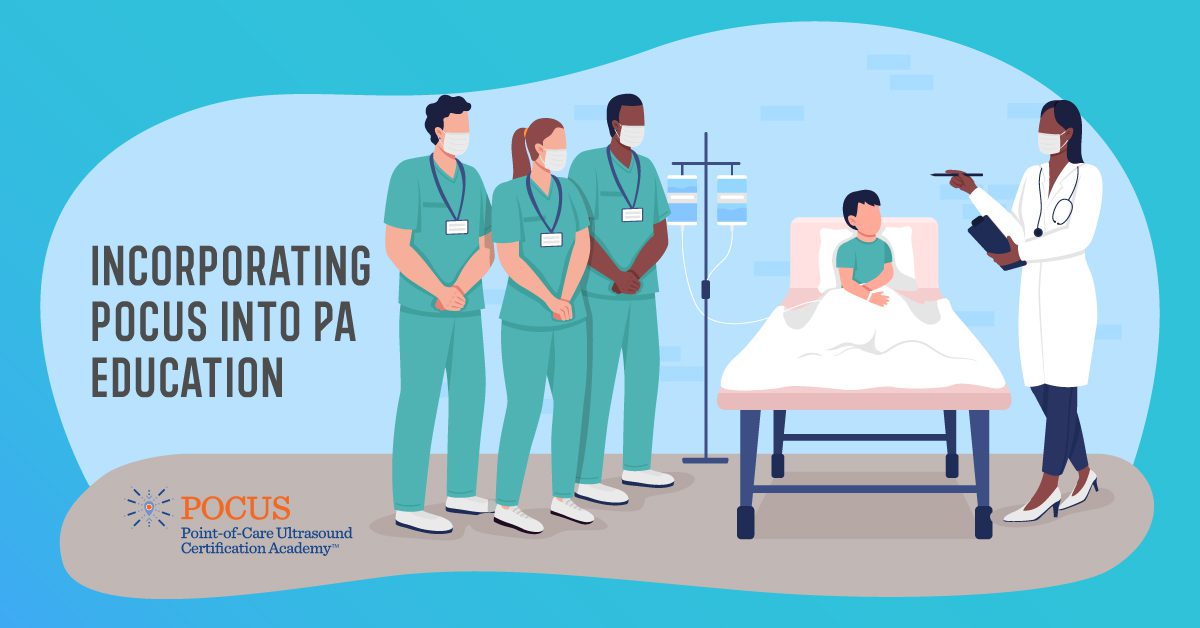By Amy Roberts, PhD, PA-C, and Christine Zammit, MS, PA-C
A primary role of a physician assistant (PA) and every other healthcare professional is to have the ability to work collaboratively. PAs utilize point-of-care (POCUS) frequently in clinical practice since they are permitted to do whatever is in the collaborative physician’s scope of practice. As a result, sharing this common knowledge with other clinicians will significantly improve this partnership. Improved collaboration and education will ultimately result in more effective and efficient patient care—what every medical provider strives to achieve.
Studies have shown that POCUS increases patient safety and even decreases diagnosis to treatment time. Additionally, exhibiting the skills necessary to perform POCUS gives new PA graduates a competitive edge in a demanding job market. The emergence of POCUS has become so crucial that PAs are now being offered the opportunity to obtain a POCUS certification through the Point-of-Care Ultrasound Certification Academy™. Therefore, it is paramount that POCUS be integrated into PA curriculums.
Although studies have demonstrated the importance of POCUS in PA education, there are many obstacles to adopting an ultrasound curriculum. Some of the main barriers PA programs often face when implementing POCUS curriculums include finding the time in an already robust schedule and the limited access to ultrasound machines. However, aligning POCUS with anatomy, medicine, and physical examination courses may help eliminate additional time in the classroom since POCUS has been found to augment anatomy and physical examination skills. Further, many organizations and hospitals have programs that donate ultrasound machines to educational institutions. There are also various grant programs that allocate funds for ultrasound training and equipment.
Our Physician Assistant (PA) Program at Hofstra University prides itself on developing interprofessional PA leaders. They are growing individuals who demonstrate clinical excellence, exhibit compassion, and advocate for health promotion and prevention to diverse communities.e clinical excellence, compassion, and health promotion and prevention to diverse communities. To fulfill this mission, our goal is for faculty and fellow PA students to be at the forefront of technology, specifically diagnostic and interventional imaging.

Our program believes in meeting the diverse needs of all our learners; therefore, we strive to use a multimodal pedagogical approach. Combining hands-on ultrasound with our courses has improved teaching instruction and our student’s knowledge and experience. For example, students are exposed to POCUS and begin hands-on training as early as their first semester of PA school.
Our program believes in meeting the diverse needs of all our learners; therefore, we strive to use a multimodal pedagogical approach. Combining hands-on ultrasound with our courses has improved teaching instruction and our student’s knowledge and experience. For example, students are exposed to POCUS and begin hands-on training as early as their first semester of PA school.
We have found that integrating a POCUS curriculum has translated into better care for the patients our students serve while on rotations and after graduation. Our program’s main skills are EFAST, DVT, and line placement. Additionally, Hofstra University’s PA program POCUS curriculum has allowed our students to augment their physical exam skills so that students can better identify anatomical structures and pathology. In pathophysiology, it has aided in diagnosing disease in a non-invasive way. During our Bioskills course, the students can now utilize ultrasound when learning to place central and peripheral lines in cadavers.
Exposing PA students to POCUS in the initial stages of academia significantly impacts leadership. Students can teach these skills to other learners while on clinical clerkships and promote the importance of POCUS to members of the interdisciplinary team. Our students have competed in the AAPA iScan competition with programs from across the nation. If POCUS is implemented at the academic training level, it can increase access to care for various patient populations.
These are just a few examples of the importance of integrating POCUS into PA curriculums, but the benefits are limitless.
Interested in validating your students’ POCUS skills? Request more information about POCUS certification!
About the Authors

Amy Roberts, PhD, MS, PA-C, graduated from Hofstra University with a Bachelor of Science and earned her Physician Assistant certificate in 2010. She then went on to earn a Master of Science in Physician Assistant Studies in December 2014 from Pace University and a PhD in Leadership from University of the Cumberlands in 2021. Amy has been working with the Hofstra Physician Assistant Program since 2012 and has been working in primary care since she graduated. Prior to becoming a PA Amy worked in radiology for more than 10 years. She continues to work in primary care with the goal of making a positive impact on the healthcare field.
 Christine Zammit, MS, PA-C, has been a practicing PA for 20 years. For the past 8 years, she has held a full-time faculty appointment at the Hofstra University PA Program. In addition to her role in academia, she maintains an active clinical practice in the pediatric intensive care unit at an inner-city hospital.
Christine Zammit, MS, PA-C, has been a practicing PA for 20 years. For the past 8 years, she has held a full-time faculty appointment at the Hofstra University PA Program. In addition to her role in academia, she maintains an active clinical practice in the pediatric intensive care unit at an inner-city hospital.





















